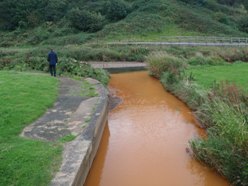
ACTION GROUP
Following a series of academic investigations the Saltburn Gill Action Group (SGAG) was formed in 2005. It is a community-based organisation, comprising local residents and representatives of local Parish and District councils, Tees Valley Wildlife Trust, local Environment Agency officers, Groundwork and geoscientists from Teesside University. Its aim is to address minewater pollution and its consequences within Saltburn, with the ambition to return Saltburn Gill and Saltburn Gill Beck to their pre-1999 condition.
By 2006 the Group had raised enough money to commission environmental consultants Entec UK Ltd to conduct an initial scoping study in 2007, followed by feasibility studies. These included investigating the condition of a nearby open shaft (2008), seasonal groundwater and hydrogeochemical monitoring (2009), and a regional review of interconnected mineworkings (2010). With funding from the Environment Agency, DEFRA and assistance from the Coal Authority, two monitoring boreholes and a larger abstraction well were drilled (2009-10), leading to the outline design and costing of likely “pump and treat” options.
HISTORICAL WORKING
Although worked for centuries, industrial underground mining of Lower Jurassic sedimentary Cleveland Ironstone Formation began around Teesside in the 1850s, following the discovery (by John Vaughan and John Marley) of the Main Seam outcrop in the Cleveland escarpment, so establishing today’s tradition of iron and steel making. Iron ore production peaked at 6.5Mt in 1883, dominating UK production until 1912 (with a total of 371Mt extracted). The last surviving mine, North Skelton, ceased production as recently as 1964.
Four principal seams were worked in this area: Avicula, Two Foot, Pecten and Main Seam. This last was the most important, stratigraphically highest, and, at typically 2.5-3m, thickest. The gently dipping seams were worked by stall and pillar methods on a rectilinear plan. Typically, two 3.6m-wide parallel roadways were driven, 9m apart, to the full height of the seam. Perpendicular tunnels or “boards” were driven for ventilation at 9m intervals. Passages were also driven at right angles to the roadways at 4.5 to 9m intervals, also with perpendicular “boards”, until the limit of working was reached. Away from villages, pillars were subsequently reduced to 1.5m2 columns as temporary support, then either allowed to collapse or removed by “goafing” (extracted and replaced with props) as mining retreated back towards the shaft.
Partial extraction rates varied from 30-60% where pillars remained, to 85-90 % for total extraction. Although in theory unmined barriers were left between different mines, abandonment records show that these were also often partially removed or cut by later drainage or ventilation drives connecting the shafts of the original mines. The result today is an interconnected area of higher permeability collapsed workings extending over the entire orefield.